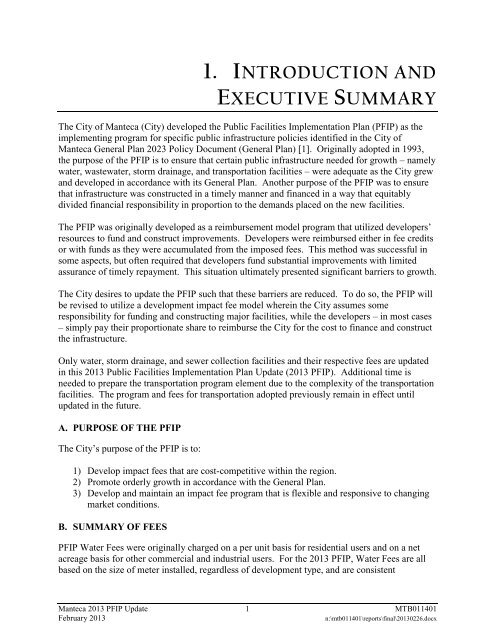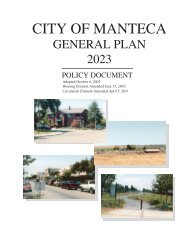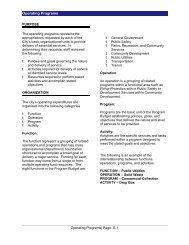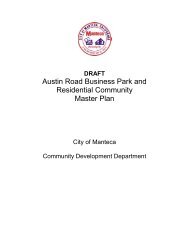2013 Public Facilities Implementation Plan Update - City of Manteca
2013 Public Facilities Implementation Plan Update - City of Manteca
2013 Public Facilities Implementation Plan Update - City of Manteca
You also want an ePaper? Increase the reach of your titles
YUMPU automatically turns print PDFs into web optimized ePapers that Google loves.
1. INTRODUCTION AND<br />
EXECUTIVE SUMMARY<br />
The <strong>City</strong> <strong>of</strong> <strong>Manteca</strong> (<strong>City</strong>) developed the <strong>Public</strong> <strong>Facilities</strong> <strong>Implementation</strong> <strong>Plan</strong> (PFIP) as the<br />
implementing program for specific public infrastructure policies identified in the <strong>City</strong> <strong>of</strong><br />
<strong>Manteca</strong> General <strong>Plan</strong> 2023 Policy Document (General <strong>Plan</strong>) [1]. Originally adopted in 1993,<br />
the purpose <strong>of</strong> the PFIP is to ensure that certain public infrastructure needed for growth – namely<br />
water, wastewater, storm drainage, and transportation facilities – were adequate as the <strong>City</strong> grew<br />
and developed in accordance with its General <strong>Plan</strong>. Another purpose <strong>of</strong> the PFIP was to ensure<br />
that infrastructure was constructed in a timely manner and financed in a way that equitably<br />
divided financial responsibility in proportion to the demands placed on the new facilities.<br />
The PFIP was originally developed as a reimbursement model program that utilized developers’<br />
resources to fund and construct improvements. Developers were reimbursed either in fee credits<br />
or with funds as they were accumulated from the imposed fees. This method was successful in<br />
some aspects, but <strong>of</strong>ten required that developers fund substantial improvements with limited<br />
assurance <strong>of</strong> timely repayment. This situation ultimately presented significant barriers to growth.<br />
The <strong>City</strong> desires to update the PFIP such that these barriers are reduced. To do so, the PFIP will<br />
be revised to utilize a development impact fee model wherein the <strong>City</strong> assumes some<br />
responsibility for funding and constructing major facilities, while the developers – in most cases<br />
– simply pay their proportionate share to reimburse the <strong>City</strong> for the cost to finance and construct<br />
the infrastructure.<br />
Only water, storm drainage, and sewer collection facilities and their respective fees are updated<br />
in this <strong>2013</strong> <strong>Public</strong> <strong>Facilities</strong> <strong>Implementation</strong> <strong>Plan</strong> <strong>Update</strong> (<strong>2013</strong> PFIP). Additional time is<br />
needed to prepare the transportation program element due to the complexity <strong>of</strong> the transportation<br />
facilities. The program and fees for transportation adopted previously remain in effect until<br />
updated in the future.<br />
A. PURPOSE OF THE PFIP<br />
The <strong>City</strong>’s purpose <strong>of</strong> the PFIP is to:<br />
1) Develop impact fees that are cost-competitive within the region.<br />
2) Promote orderly growth in accordance with the General <strong>Plan</strong>.<br />
3) Develop and maintain an impact fee program that is flexible and responsive to changing<br />
market conditions.<br />
B. SUMMARY OF FEES<br />
PFIP Water Fees were originally charged on a per unit basis for residential users and on a net<br />
acreage basis for other commercial and industrial users. For the <strong>2013</strong> PFIP, Water Fees are all<br />
based on the size <strong>of</strong> meter installed, regardless <strong>of</strong> development type, and are consistent<br />
<strong>Manteca</strong> <strong>2013</strong> PFIP <strong>Update</strong> 1 MTB011401<br />
February <strong>2013</strong> n:\mtb011401\reports\final\<strong>2013</strong>0226.docx
















